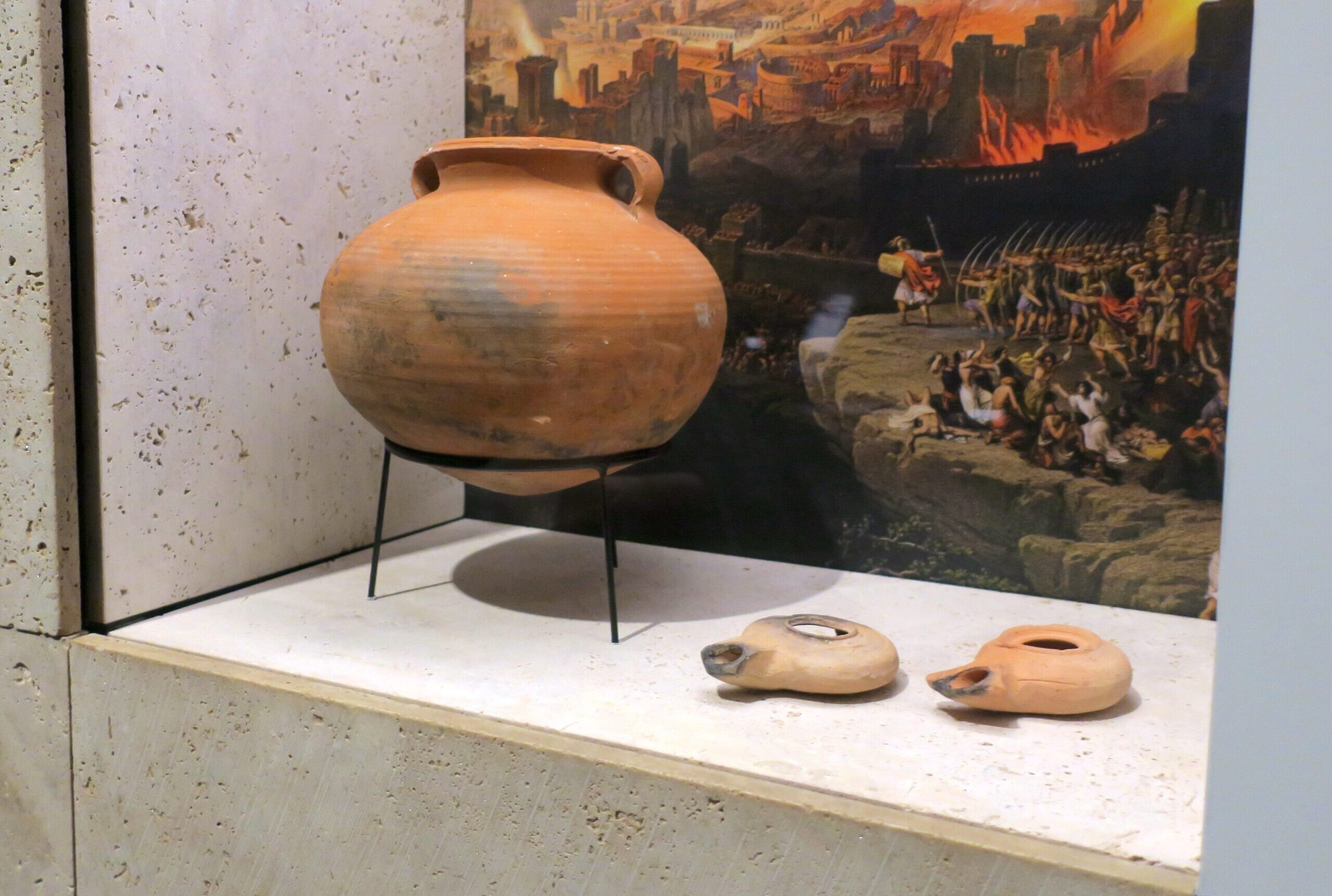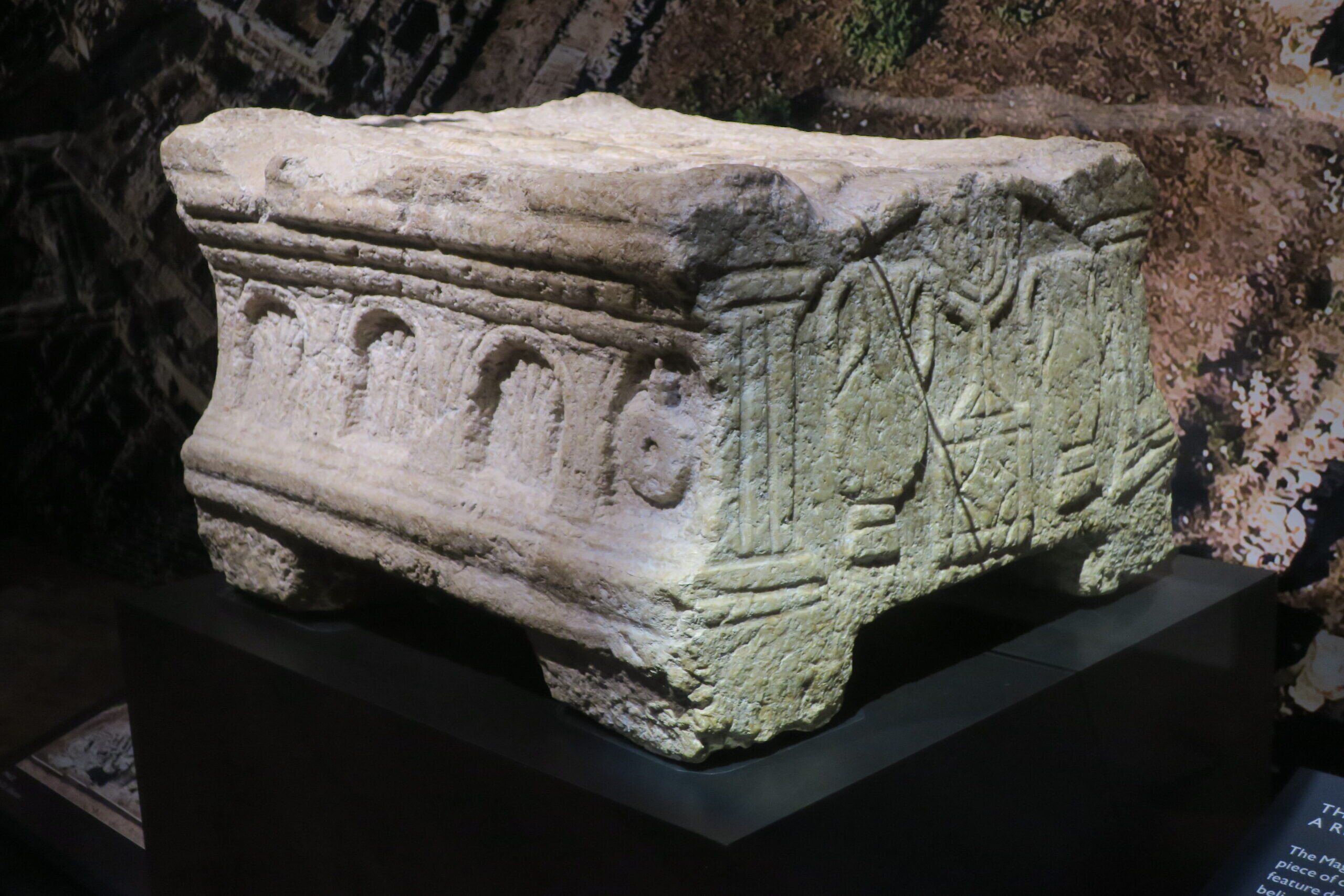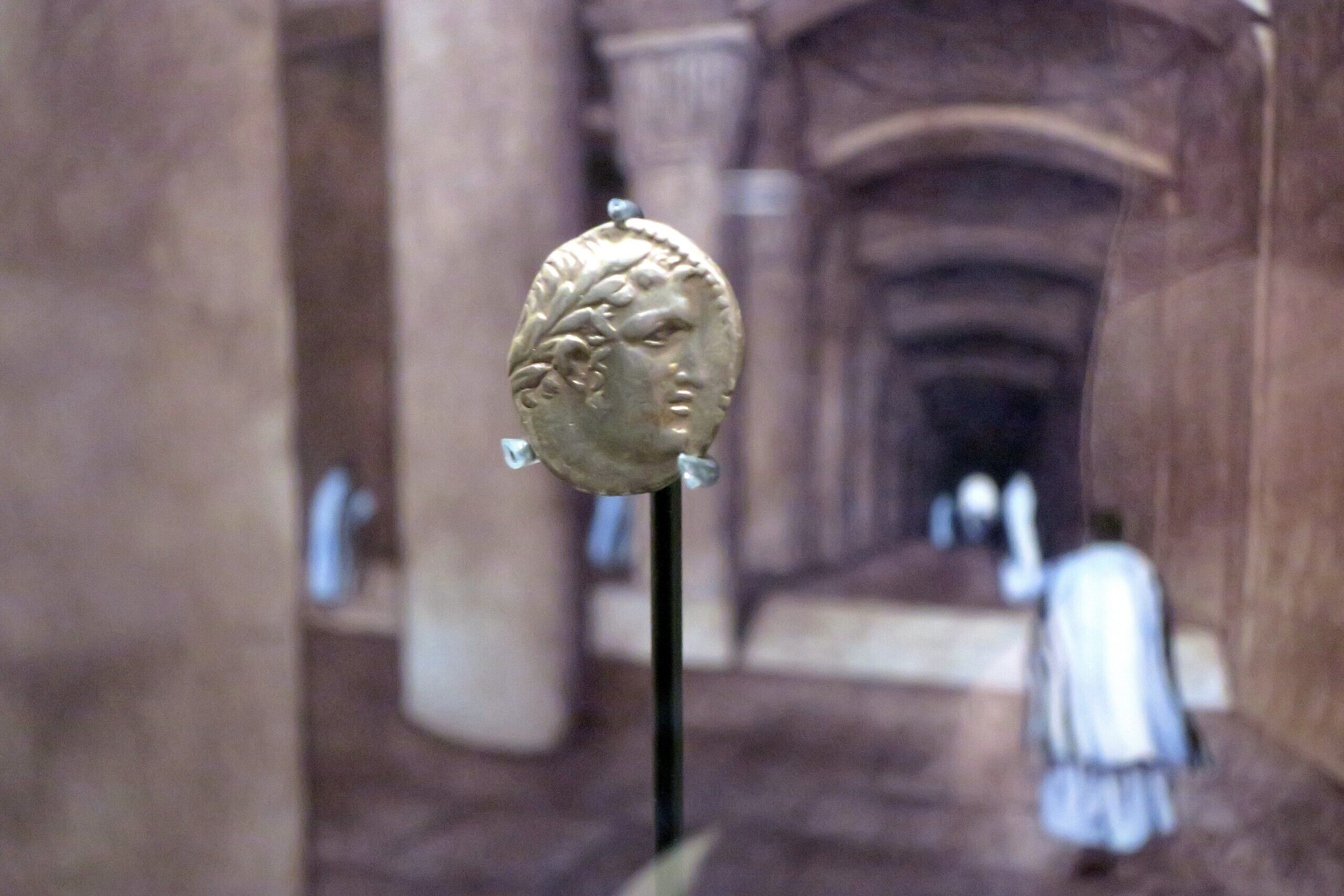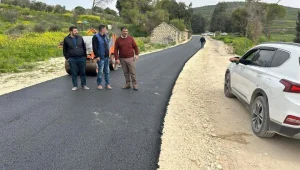(JNS) At first blush, a vitrine in a new Museum of the Bible exhibition in Washington seems unremarkable. An earthy orange jug with handles overlooks two small oil lamps, all set before a reproduction of part of David Roberts’s c. 1850 painting of Titus commanding the siege and destruction of Jerusalem in 70 CE.
Navit Popovich-Geller, a Jerusalem native and curator at the Israel Antiquities Authority, told JNS that the “simple cooking pot,” set alongside “simple oil lamps,” shows visible signs of use.
Josephus described Jewish rebels hiding in cisterns—water storage tanks—and drainage tunnels from the Romans. “They thought they would be saved, and the Romans would go,” Popovich-Geller said. “It didn’t happen.”
To stay alive, people need a cooking pot, lights and jugs from which to drink. “You see it was used. It’s just a cooking pot,” she told JNS. “It’s not special, but the story—and you think about those people, who sat there in the drainage tunnel, and they hear. You can really relate to it, even though it’s just a cooking pot.”
Having handled the objects, she told JNS that they are lighter and more fragile than one might think. A takeaway from the objects, and from the broader Dead Sea Scrolls exhibit (through Sept. 7) at the Museum of the Bible in Washington, is that Jerusalem was a bustling place, according to the Israeli curator.
“It was a sacred city, the Temple city, but also a big metropolis with a lot of commerce and a lot of activities,” she told JNS. “Sometimes, people forget it was not just the Temple.”
Looking at the bowl and lamps with Popovich-Geller required turning one’s back on fragments of the Dead Sea Scrolls—arranged outward facing in a circle at the museum to prevent the “massive congestion points” and two-hour lines in the previous venue for the show, according to Rena Opert, director of exhibits and collections specialist at the Bible Museum.
When Opert asked the Ronald Reagan Presidential Library and Museum in Simi Valley, Calif., where the show was on view from November 2024 until last September, why a Dead Sea Scrolls exhibit was there, she was told because the former president met with Israeli Prime Minister Menachem Begin.
The Ten Commandments fragment from the Dead Sea Scrolls was on view in California, but not in Washington. The scrolls hibernate for five years after they are shown—for just a few months at most—for their own protection, so the fragments on view in Washington will change two more times before the exhibit ends.

Cooking pot and oil lamps with visible signs of use, early Roman period, first century to 70 CE, City of David, Jerusalem, collection of the Israel Antiquities Authority, on view in a Dead Sea Scrolls exhibit at Museum of the Bible in Washington, DC, on Nov. 21, 2025. Photo by Menachem Wecker.
Beyond turning the scrolls outward, unlike the Reagan library, which had visitors view them from within a circular arrangement, another innovation of the Bible Museum show was to create a ramp upon which to display a rock from Jerusalem’s Pilgrim Road, so that viewers could walk on and touch it, Opert told JNS. The Washington show also unfolds on one floor, while the California one was split into two.
Robert “Bobby” Duke, chief curatorial officer at the Bible Museum and director of its Scholars Initiative, wrote his dissertation on Aramaic documents from Qumran and has studied the Dead Sea Scrolls extensively, including in Israel.
“The Dead Sea Scrolls are the most significant archaeological discovery ever,” he told JNS. “I’ve seen King Tut’s treasures. Fantastic. They’re beautiful, but they don’t have an ongoing reality when it comes to people of faith today. The Dead Sea Scrolls are directly connected to people who read scripture today.”
The scroll fragments “don’t have the same visual appeal, but this exhibit is so much more than just the fragments,” he said. “It’s telling an entire story.”
“The whole exhibit starts in the Galilee and then makes its way down to the wilderness outside of Jerusalem, so it really tells the whole story of Second Temple Judaism, which is so formative for rabbinic Judaism and for the development of the New Testament world,” he said.
Seeing groups of schoolchildren at the Israel Museum in the Shrine of the Book, which houses the Dead Sea Scrolls, including the best preserved one, the Isaiah manuscript, made an impression on Duke. “Children, who can still read this text that’s 2,000 years old, as if they’re reading a modern document,” he said.
The exhibit takes on particular significance at the Bible Museum, which also has the Megiddo Mosaic, the “oldest church ever discovered archaeologically,” and “we now have some of the oldest portions of scripture ever simultaneously,” Duke said. “This is the only place in the world that that is true.”

Stone slab from Pilgrimage Road in front of Magdala stone, collection of the Israel Antiquities Authority, on view in a Dead Sea Scrolls exhibit at the Museum of the Bible in Washington, DC, on Nov. 21, 2025. Photo by Menachem Wecker.
‘Kind of in awe’
Opert, the Bible Museum’s director of exhibits, led JNS on a tour of the show that ran about an hour and a half on Friday, the day before it opened to the public.
Curated by three Israel Antiquities Authority scholars—Popovich-Geller and her colleagues Risa Levitt and Joe Uziel—and designed by the production company Running Subway, the show is organized by time and place.
“They want to transport you from Washington, DC, to Israel, and then they start in the Galilee and work the visitors down through Jerusalem, then out to Qumran in the Judean Desert and then also through time,” Opert told JNS, as she led through an introductory room with video screens and a few artifacts. “You begin in the present day, and you go back to Second Temple Judaism.”
After the video completed, a screen lifted to reveal a doorway into the next gallery, which displayed a first-century fishing boat that was found in 1986. A vitrine displayed fragments from the real artifact, all set in an artistic reproduction of the boat to give viewers a sense of its scale.
“For the audience, both Jewish and Christian, it’s interesting, because you’re looking and thinking about the fishing villages that would have surrounded the Sea of Galilee,” Opert said. “For Christians, to imagine Jesus and his followers in that area and in boats such as these.”
The exhibit was planned well before Oct. 7, according to Opert, who recalled the museum having a conversation about it at least as far back as 2022. The museum had nothing to do with the show, which it rented and which arrived in full, she said. Popovich-Geller told JNS that she and her two Israel Antiquities Authority colleagues had complete control over curatorial decisions, and they wrote the labels and wall texts.
As Opert led JNS into the next room, she said that the museum merged two galleries to fit the temporary exhibit, which is displayed on the museum’s fifth floor, near its gallery on “the people of the land,” a long-term exhibit from the Israel Antiquities Authority. (The latter gallery might be the only place in Washington, beyond its embassy, where the Jewish state tells its own story.)
Standing in front of a timeline with objects that aim to help viewers understand who lived in Israel from 70 CE to the present, JNS asked Opert what object or objects she would want to add to the show if it didn’t arrive already formed. (The museum tends to refer to BC and AD, although the exhibit labels use BCE and CE.)
“They did a really good job with it, because it’s not just a display of the scrolls, which of course in and of themselves would be powerful, but they added so many wow objects for the audience that I think you have moment after moment where you’re kind of in awe,” she said, “starting with the first century boat, and we’re about to round the corner to the Magdala stone.”

Magdala stone, collection of the Israel Antiquities Authority, on view in a Dead Sea Scrolls exhibit at the Museum of the Bible in Washington, DC, on Nov. 21, 2025. Photo by Menachem Wecker.
Around the corner, the Magdala stone, which was found in a first-century synagogue in Magdala, the city associated in Christian scripture with Mary Magdalene, was “likely used for the liturgical reading of the Torah and other sacred scrolls,” according to the Bible Museum.
“It features detailed reliefs of the temple and its ritual artifacts, including the earliest-known carving of the Temple menorah, and suggests the sculptor had made the pilgrimage to the temple in Jerusalem,” the museum website states. “These reliefs provide insights into the role of synagogues as sacred spaces prior to the temple’s destruction.”
Opert told JNS that she has “already witnessed people crying over it. It’s really compelling.”
“I’m as moved by this as I am by the Dead Sea Scrolls,” she added of the stone. “I think they did a really good job with the storytelling.”
The stone dates to before the destruction of the Second Temple. “We can’t say anything with certainty about it, other than that we might think that the artist had seen the vessels in the Temple prior to the destruction,” Opert told JNS.
“So seeing the depiction of the menorah here from the Temple is something that’s very moving to a Jewish audience, and probably a Christian audience as well,” she said.
The stone also depicts other vessels, arches, and rosettes, or rose-shaped designs that often appear as Jewish symbols.

Dried date and pit alongside wooden bowl from a local tree, Qumran, Roman period, on view in a Dead Sea Scrolls exhibit at the Museum of the Bible in Washington, DC, on Nov. 21, 2025. Photo by Menachem Wecker.
Stone in the road
As viewers pass the Magdala stone, they walk over a ramp, designed to look like it is made of Jerusalem stone and which includes an actual stone from the road, over which pilgrims walked in the Second Temple period.
Like another stone in the long-term Israel Antiquities Authority gallery at the museum and a three-and-a-half-ton stone from the Western Wall at the end of the exhibition, visitors can touch the object.
In the next gallery, objects are installed on temporary walls that look like Jerusalem stone and in vitrines in the middle of the room, and viewers can look through several slits in the walls to see diorama-like installations behind glass behind the walls that offer glimpses of relevant scenes.
Among the displayed items are shells, dice, leather sandals, linen textiles used to protect the scrolls and a date and a date pit. One vitrine contains a Tyrian shekel, minted before 19 BCE and weighing half an ounce, which was the only coin accepted for a Temple tax. A separate gallery tells the story of Masada.
The next gallery, a large open space, contains the Dead Sea Scrolls and the vitrine with the cooking pot and lamps.

Tyrian shekel, minted before 19 BCE and weighing half an ounce, was the only coin accepted as a Temple tax, collection of the Israel Antiquities Authority, on view in a Dead Sea Scrolls exhibit at the Museum of the Bible in Washington, DC, on Nov. 21, 2025. Photo by Menachem Wecker.
“People know ‘Dead Sea Scrolls,’ the phrase. We wanted to set it in the time and place, so that the viewer can comprehend and understand that it was not in a void. It had context,” Popovich-Geller, the curator, told JNS.
She told JNS that the Israel Antiquities Authority plans to open a visitor center in about one-and-a-half to two years. It will have a small exhibit with a few scrolls on view, including Dead Sea Scrolls, she said.
The display of the scrolls juxtaposes the fragments, which can be very difficult to read due to their size and condition, alongside images of the texts and interactive displays that explain them.
From when the exhibit opened on Saturday until February, the first rotation of Dead Sea Scrolls includes 4Q7 Genesis(g), 11Q10 Targum Job, 4Q83 Psalms(a), 4Q210 Astronomical Enoch(c), 4Q434 Barkhi Nafshi(a), 4Q491 War Scroll(a), Eschatological Commentary A and 11Q20 Temple Scroll(b), per the museum website.
From February to May, the scrolls on view will be 11Q5(a) Psalms (Great Psalms Scroll Fragments), 4Q27 Numbers(b), 4Q111 Lamentations, 4Q264 Community Rule(j), 4Q448 Apocryphal Psalms and Prayer, 4Q274 Tohorot A (Purities), 4Q400 Non-Canonical Psalms A and 4Q530 Book of the Giants(b), per the museum. And from May to September, the third planned rotation is 4Q58 Isaiah(d), 4Q197 Tobit(b), 4Q130 Phylacteries C, 4Q534 Birth of Noah(a), 4Q218 Jubilees(c), 4Q275 Communal Ceremony, 4Q258 Community Rule(d) and 4Q271 Damascus Document(f).
The Genesis scroll on view includes the first chapter of the book, starting “In the beginning, God created the heavens and the earth.” The scroll is “remarkable” for “how closely it matches Hebrew bibles copied nearly 1,000 years later—demonstrating extraordinary consistency across a millennium,” per a label in the exhibit. “Many other biblical texts from Qumran show variations from later versions, making Genesis’s stability significant.”
Scholars have been able to read the “dark, coarse parchment fragments” with multispectral imaging, which can reveal the text, it adds. A lower part of the fragment sustained damage before the text was written, “as indicated by the ancient stitches used to repair the leather and the text, which leaves empty spaces around the stitches,” per the label.
An eschatological commentary fragment includes interpretations of parts of 2 Samuel 7 and Psalms 1-2, “focusing on restoring David’s dynasty through the coming Messiah and the end of times,” per a label. “During the Second Temple period, many Jews anticipated a future anointed king who would restore Israel’s independence and establish God’s kingdom. This was not yet the Christian concept of divine savior, but rather an expected political and religious leader from David’s lineage.”
The Enoch scroll has never been on display before, according to Opert. Per the label, it comes from what is “among the earliest surviving Jewish texts outside the Bible,” dated to the third or fourth century BCE. The Books of Enoch “expand on brief biblical hints about Enoch,” great-grandfather of Noah, who, per Genesis 5:24 “walked with God, and he is no more, because God took him.”
“The Books of Enoch elaborate this into detailed accounts of Enoch’s heavenly ascent and angelic journeys, likely containing our earliest version of the fallen angels myth,” the label says. “These books profoundly influenced the Dead Sea Scrolls community, shaping their distinctive 364-day solar calendar.”

Notes on a stone from the Western Wall on view in a Dead Sea Scrolls exhibit at the Museum of the Bible in Washington, DC, on Nov. 21, 2025. Photo by Menachem Wecker.
‘How young we are’
As Opert led JNS through a digital gallery devoted to the Ten Commandments scroll, she said that a local Jewish day school and synagogue have expressed interest in seeing the exhibit.
In a science gallery, Opert pointed out a photo of scholars chain-smoking over the scrolls. “You’d think there would be some fear of incinerating them,” she said.
She also noted technologies that show how scholars have digitally unraveled fragile scroll fragments to read them in previously impossible ways.
A label near the 3.5 ton Jerusalem stone at the end of the exhibit—which simulates the Kotel but without a mechitzah partition—notes that “the term ‘Wailing Wall,’ coined by non-Jewish observers during the Ottoman and British rule who witnessed people mourning the Temple’s destruction, is considered disrespectful by many Jews, who prefer ‘Western Wall’ or ‘Kotel,’ as it focused on the wall’s physical location.”
The museum says that visitors may place prayers or messages in the simulated wall. “A cherished tradition, dating to the 18th century, invites visitors to place written prayers (kvitlach) between the stones,” a wall text states. “These notes, expressing personal hopes and requests, are collected twice yearly and buried on the Mount of Olives.”
On the other side of the wall, a live feed of the Kotel was temporarily paused, as it was already Shabbat in Israel while JNS viewed the exhibit.
JNS asked Popovich-Geller, the curator, about recent tendencies even in major news publications, to refer to Jews “believing” that there was a Temple in Jerusalem. The same publications used to refer to efforts to erase Jewish presence on that site, including claims from Palestinian leader Yasser Arafat, as denying what is a scholarly consensus about the Jewish Temples.
Popovich-Geller told JNS that the Israel Antiquities Authority focuses on objective scholarship and not politics, but still objects like the ones in the show engage in some hasbarah, or public diplomacy.
“There was a Temple. Obviously, there was a Temple. We find evidence of it,” she told JNS. “I’m not a right-wing person politically, but Jews were there. We can’t bend the story—to tell there were no Jews is problematic.”
“I don’t even know what to say,” she added.
JNS asked Duke, the museum’s chief curatorial officer, separately about what it means to be around such ancient objects.
“I think being close to anything that old,” said Duke, who recently saw the pyramids in Giza, Egypt, “just to remind yourself that you’re looking at something that is thousands and thousands of years old.”
“Particularly for all of us in North America, where we are celebrating our 250th anniversary next year, you realize how young we are as a nation,” he said.
Want more news from Israel?
Click Here to sign up for our FREE daily email updates














